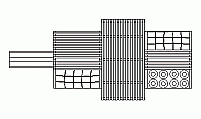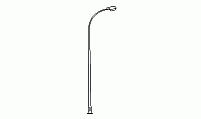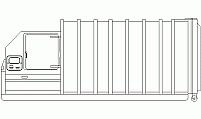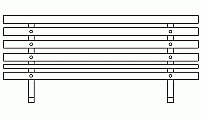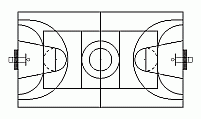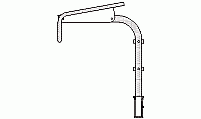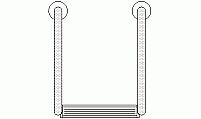CAD Blocks categories
 3D models
3D models home furniture
home furniture sanitary ware - bathrooms
sanitary ware - bathrooms professional equipment
professional equipment doors and windows
doors and windows people and animals
people and animals plants and trees
plants and trees vehicles - transports
vehicles - transports architectural details
architectural details mechanical - electrical
mechanical - electrical urban planning - civil works
urban planning - civil works safety health construction
safety health construction accessible design
accessible design drawing sheet
drawing sheet signals
signals construction machinery
construction machinery accessories and objects
accessories and objects maps and street maps
maps and street maps
Public Drinking Fountain CAD Block for Urban Spaces

size: 5 kb
category: street furniture
related categories:
description: Top-down view of a public drinking fountain featuring two concentric circular sections, a support structure, and a water spout with a drainage basin.
file extension: .dwg CAD - AutoCAD software
Key Features and Technical Details of Public Drinking Fountains
Detailed Structure of the Drinking Fountain
This drinking fountain features a thoughtfully engineered design consisting of two concentric circular sections of different diameters. The left section forms the primary support structure, with a wide base for increased stability and narrower dimensions as it rises to support the water spout. This ensures that the fountain remains secure and resistant to external forces in public spaces.
The right section serves as a circular basin that collects and contains the dispensed water, functioning as a drainage area. At the center, a double-rectangular representation signifies the integrated water spout, which bridges the two sections. This design optimizes water distribution while maintaining aesthetic appeal. Public drinking fountains like this are essential for hydration in parks, streets, and urban areas, combining functionality with a durable, ergonomic structure.
Standard Dimensions and Measurements
According to ADA guidelines, the height of the water spout for accessible fountains must not exceed 36 inches (91.4 cm) from the ground to allow use by wheelchair users. For fountains designed for children, the spout height is typically 30 inches (76.2 cm) or less, ensuring accessibility for younger users. These measurements are essential for compliance with modern accessibility standards.
The circular basin generally has a diameter of 12 to 24 inches (30.5 to 61 cm), ensuring ease of access and efficient water containment. The base of the support structure is commonly larger, with diameters of up to 30 inches (76.2 cm), tapering as it rises to provide both stability and a sleek appearance. These dimensions are in line with industry standards set by manufacturers in the U.S. for public hydration stations.
Installation and Material Considerations
- What materials are typically used?
- Public drinking fountains are commonly made from materials such as stainless steel, cast iron, and reinforced concrete. Stainless steel is highly preferred for its corrosion resistance and ease of cleaning, making it ideal for outdoor environments exposed to weather and heavy use. Cast iron offers robust durability and is often used for traditional or decorative fountains, while reinforced concrete provides stability and can be molded into various designs. These materials ensure longevity and minimal maintenance in public settings.
- How is the fountain installed?
- The installation process of a public drinking fountain begins with preparing a stable concrete foundation to secure the base. This foundation provides the necessary support to prevent shifting or tilting over time. Plumbing connections are then established to the municipal water supply, ensuring proper water flow. Finally, anchoring bolts or brackets are used to secure the fountain structure to the base, ensuring stability and resistance to external forces such as vandalism or weather conditions.
- What type of drainage system is recommended?
- A concealed drainage system is recommended for public fountains to efficiently handle excess water and prevent pooling. This often includes a drainage pipe connected to the basin, directing water to a designated waste area. Perforated grates or catch basins may also be used to filter debris and prevent clogs. Regular maintenance of the drainage system is essential to ensure proper functionality, especially in high-traffic areas where water usage is frequent.
- What maintenance is required?
- Maintaining a public drinking fountain involves regular cleaning of the surfaces to remove dirt and bacteria. The plumbing system should be inspected periodically for leaks or blockages, while the water quality must be tested to ensure safety for public use. Seasonal checks are also recommended to address potential damage from freezing temperatures in colder climates. By performing routine maintenance, the fountain can remain functional and safe for long-term public use.
- Are these fountains ADA-compliant?
- Yes, most modern public drinking fountains are designed to meet ADA compliance standards. This includes spout heights no higher than 36 inches (91.4 cm) to allow wheelchair access, as well as lever-activated mechanisms that are easy to operate for individuals with limited mobility. ADA-compliant fountains often feature dual-height designs, making them accessible for both adults and children. These features ensure inclusivity and usability for all members of the community.
Advantages of Modern Public Fountains
Modern public fountains are designed with a focus on accessibility, durability, and aesthetics. Their ergonomic design ensures they are easy to use for a wide range of users, from children to individuals with mobility impairments. Additionally, the use of durable materials such as stainless steel and cast iron guarantees long-lasting performance in harsh outdoor environments.
Compared to older designs, modern fountains incorporate advanced drainage systems to prevent water pooling and minimize maintenance needs. Their aesthetic appeal enhances public spaces, making them functional and attractive. These fountains encourage hydration, promote sustainability, and serve as focal points in urban landscapes, making them indispensable for community health and well-being.
History and Global Adaptations of Public Fountains
Public fountains have been an essential part of urban infrastructure since ancient civilizations, providing communal access to drinking water. Early fountains were often powered by natural springs or aqueducts and served as landmarks in city centers. Over time, these designs evolved into decorative and functional structures, especially during the Renaissance and Victorian eras.
Today, public fountains vary widely across the globe, from minimalist stainless steel dispensers in urban settings to ornate marble fountains in historical squares. Solar-powered fountains and eco-friendly materials are becoming increasingly popular, reflecting the growing emphasis on sustainability. Regardless of design, public fountains remain a vital resource for hydration and community interaction.










